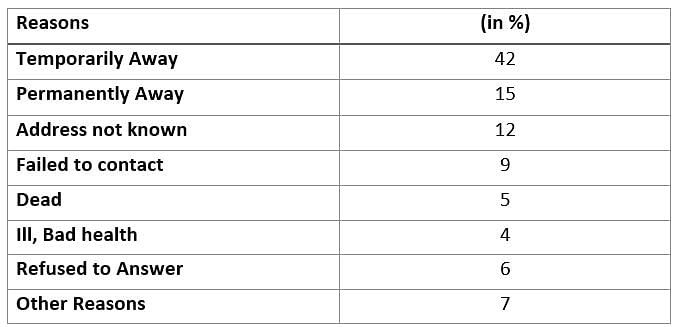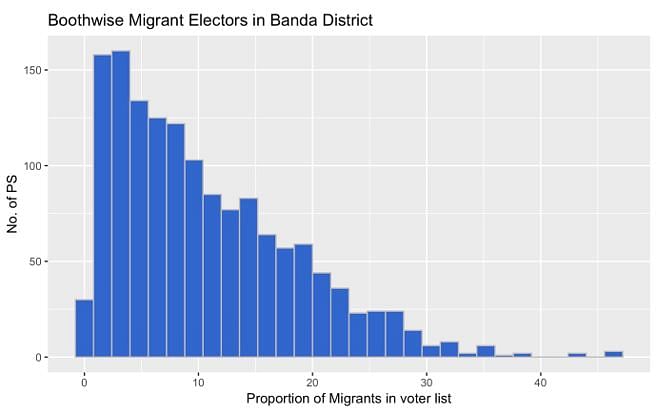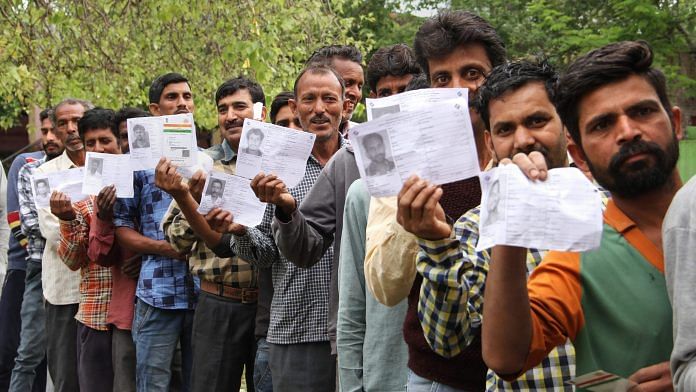The polling in Delhi and Gurgaon this Sunday witnessed nearly five percentage point lower turnout than 2014.
There were memes and jokes on social media about how people in the national capital region prefer to go for their salsa classes or holiday in the hills instead of standing in queues in the scorching summer heat to vote.
Why do some Indian citizens fail to exercise their right to vote?
Many point to the apathy towards the political system as the most important reason for not voting. While this may be true for some, but the voter turnout has largely remained the same as 2014 – both in urban and rural India.
We find enough evidence that shows various problems in electoral rolls have become stumbling blocks preventing citizens from exercising their right to vote. Our conclusion is based on the research we conducted both in urban and rural locations during this election (Noida and Ghaziabad on 11 April, Banda, a rural district in Bundelkhand region of Uttar Pradesh on 29 April, and Delhi on 12 May).
The National Election Study (NES) surveys for the past two decades (1999, 2004 and 2009) have consistently shown that only one in 10 electors did not vote because of lack of interest in politics. The sampled respondents in the NES surveys are only those whose names appear on the electoral rolls. Around half of them who agreed to be interviewed for the survey could not vote because either they were traveling on the polling day or were ill.
Also read: UP’s 1.3 lakh polling booths: What affects voter turnout on election day
Approximately one-third could not vote because they either lacked proper identity cards or their names on the electoral roll did not match with the identity cards they carried to the booth. The lack of identity cards was more of a problem among the rural than urban voters and apathy or disinterest in the elections was more common among voters in metropolitan cities.
‘True’ voter turnout vs official turnout
During our research in the 2019 Lok Sabha elections, we noted that the ‘true’ voter turnout may be higher than the official turnout figures. This happens because dead voters or those who have moved out of a locality/village remain on the voter list. To be sure, the Election Commission of India (ECI) revises electoral rolls before every election. The 2019 electoral rolls in Uttar Pradesh have been revised thrice between December 2018 and April 2019. Despite this tremendous effort by the ECI officials, electoral rolls remain incomplete.
Presence of names that should not have been on the rolls inflates the denominator and leads to a downward bias for the turnout estimate. Put simply, turnout is calculated by dividing the numbers of voters by the electors. But, if the number of electors is artificially high, then turnout estimate would be lower than the true figure.
The NES 2009 had an innovative feature, which involved collecting information on those who could not be interviewed during the survey. While 36,169 people were interviewed for the survey, field investigators managed to gather some basic data on another 17,528 electors who were part of the sample but could not be interviewed. The data presented in Table 1 indicates that at least 20 per cent of the registered electors should not have been on the electoral rolls as they either did not live in that locality or were dead. To ensure that there was no selection bias between these two groups, we found that those not interviewed were nearly identical to the final set of respondents in the survey in terms of their demographic profile.
Table 1: Reasons for ‘Not interviewed’ in NES 209

Also read: The Indian election story of focussing on NRI voters, not doing enough for domestic migrants
Migration & turnout
During our research in Banda, where there has been a substantial increase in turnout between 2014 and 2019 due to massive voter mobilisation by the district administration, we collected a baseline figure of migration across 1,454 polling stations. Figure 1 displays the migration rate and it is evident that many polling stations had more than one in every five registered voters not living in the area. We found that some migrants did return to vote, but their numbers were minuscule compared to the total number of migrants.
Figure 1

Our analysis suggests that turnout in polling stations with high migration (25 per cent and above) was three percentage point lower than the overall average. Not surprisingly, we found this difference only for male turnout, not female, as migration in India is largely among men. This evidence suggests that recent contraction of gender gap (i.e. the difference between male and female turnout) may be a statistical artefact if one accounts for the proportion of migrant electors.
One family, many polling centres
Another problem we noted was that there were numerous instances of immediate family members finding themselves registered at polling centres located a few kilometres apart from each other. This problem occurs as the newer additions may get assigned to a different polling station if the other station has reached the maximum number of electors it can have.
There were fewer instances of this problem in Banda, but it was more pronounced in NCR. This discourages many people to go out and vote. Voting in India is a collective exercise, people turn out with family, friends or neighbours. The problem of multiple polling station assignment to members of the same family or neighbourhood lowers the turnout because those assigned the farthest polling station do not want to travel and stand alone in queues and wait for their turn.
The vulnerable groups
There are indeed other areas of concern vis-à-vis electoral rolls, such as those living in the locality but their names missing from the electoral rolls. Although migrants are the worst victim of such exclusion, there are other groups as well who face this problem. For example, Prannoy Roy and Dorab Sopariwala in their book The Verdict: Decoding India’s Elections compare the Census information with the registered voter profile and estimate that 21 million women are missing from the electoral rolls.
Also read: Women voters in Indian democracy: A silent revolution
Similarly, Abusaleh Shariff and Khalid Saifullah from their research in Karnataka conclude that approximately one-sixth of the total adult population is not on the rolls and Muslims and Dalits face more exclusion than any other group.
While such exclusion from the electoral rolls must be rectified immediately, we must understand that this is a registration problem with no bearing on the turnout figures.
The 2019 Lok Sabha elections have reached their penultimate phase and it has become increasingly clear that the drive to increase voter turnout needs new strategies. We hope the Election Commission takes cognisance of the discrepancies we have highlighted about polling stations and electoral rolls.
Pradeep Chhibber and Pranav Gupta are at the University of California at Berkeley, US. Rahul Verma is a Fellow at the Centre for Policy Research. Views are personal.






